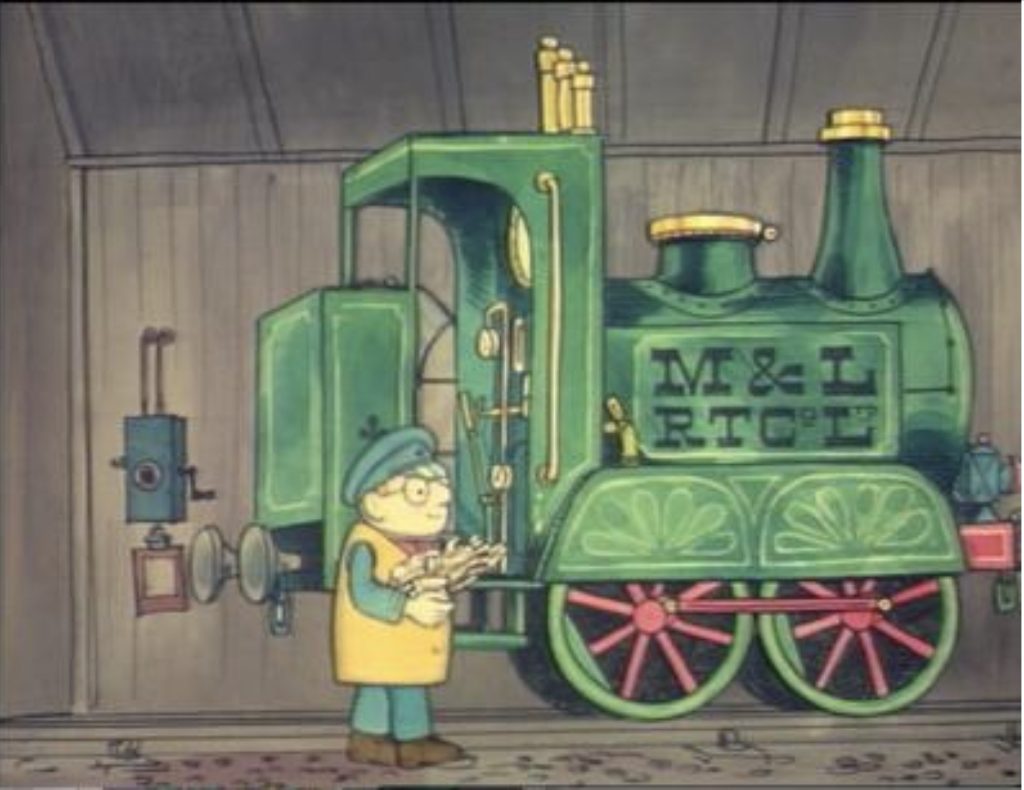Growing up in Northern Ireland in the 1970s, the steam train was a throwback to the past. The little green steam engine, Ivor, who worked for The Merioneth and Llantisilly Railway Traction Company Limited that appeared on the tv screen every evening belonged to another world. Through Ivor, my introduction to Wales was a land I believed was full of dragons and people, and trains, who liked to sing. Oliver Postgate’s soothing, lyrical voice was already the aural soundtrack to my childhood. The voice behind the Samllfilms’ animation productions Bagpuss (1974), Noggin the Nog (1959) and the Clangers (1969) now also told of the adventures of Ivor the little green steam engine in a passable-to-me Welsh accent.
‘Ivor the Engine’ (1959) was actually the first production from the British television production company Smallfilms, created by Oliver Postgate and Peter Firmin (see figure 1). They set up the studio in a converted cow shed on Peter Firmin’s farm in Kent. The idea came about after Oliver Postgate heard stories from a Welshman Denzyl Ellis during World War II. Ellis was a former railway fireman and described to Postgate how the engines seemed to come to life when they started up in the mornings. Postgate was heavily influenced by the radio play ‘Under Milk Wood’ (1954) by Welsh poet Dylan Thomas, which focused on the community of a small Welsh fishing town. Postgate used the same technique of giving his characters a name which included their occupation. In ‘Under Milk Wood’, the chapel musician is Organ Morgan and Postgate expanded this with the engine driver being called Jones the Steam, the station master being Dai Station and Ivor’s choirmaster was Evans the Song.
Ivor the Engine was originally screened as a series of six black and white episodes in 1959 on ITV, the new independent British television channel. These 6 episodes acted as an origin story and explained how Ivor came to have a three-note whistle from an old fairground steam organ and was thus able to sing bass in the Grumbly and District Choral Society. This then led to a further 20 episodes being commissioned and screened between 1959 and 1964. When the British Broadcasting Corporation (BBC) asked Postgate to recreate the episodes in color in 1975, they didn’t recommission the original 6 episodes so everyone watching in the 1970s just accepted that Ivor had this unusual 3 note whistle which allowed him to sing. Postgate wrote the scripts, narrated the stories and animated the character, while partner Peter Firmin frantically painted the cardboard cut-out characters, props and backgrounds. The pair of them produced, on average, an incredible two minutes of animation a day, using a stop-motion animation technique with cut-out card characters and props on a watercolor background.
Ivor the Engine was produced in a time, and in a way, that is unimaginable to the current crop of animation producers. Quoted by Anthony Hayward (2008), Postgate described it as:
We would go to the BBC once a year, show them the films we’d made, and they would say, ‘Yes, lovely, now what are you going to do next?’
continuing to explain that
We would tell them, and they would say, ‘That sounds fine, we’ll mark it in for eighteen months from now’, and we would be given praise and encouragement and some money in advance, and we’d just go away and do it.
Ivor was a genteel rebel. He wasn’t always happy doing as he was told and wanted to spend his days heading off for trips to the seaside rather than shunting carriages and would often cut corners in his rush to get to choir practice on time. While Thomas in the frist series Thomas the Tank Engine and Friends (1984, David Mitton and Britt Allcroft) was a goodie two shoes always looking for praise from the Fat Controller for being a really useful engine, Ivor was an individual who was capable of driving himself off to the seaside or to sing in the choir even without Jones the Steam being a willing accomplice. Each 5-minute classic was a beautifully compact tale, with a host of characters including Idris the Welsh dragon who sleeps in Ivor’s firebox and Dinwiddy the miner who spends his days setting off explosions to mine for gold which he then gives away.
Oliver Postgate’s wonderful scripts and soothing, lyrical narration, together with Peter Firmin’s beautiful watercolor painted cardboard cut-outs created a genteel, wondrous “top left-hand corner of Wales” (Postgate, 1959). A land that didn’t suffer the winter of discontent, where there were no strikes or three-day-weeks and the army wasn’t on the streets. The simple animation worked with the simple stories that charmed a generation, and Oliver Postgate’s soothing words and the “pssssh-ti-cufff’ sound Ivor made would lull a tired 4-year-old to sleep before the Six O’clock news came on.
References
Hayward, A. (2008) Oliver Postgate: Creator of ‘Bagpuss’, ‘The Clangers’ and ‘Ivor the Engine’ who turned children’s television into an art form, The Independent, 10 December 2008. Available at: https://www.independent.co.uk/news/obituaries/oliver-postgate-creator-of-bagpuss-the-clangers-and-ivor-the-engine-who-turned-children-s-television-into-an-art-form-1059366.html
Postgate, O. (1959) “Ivor the Engine”, Smallfilms. Available at: http://www.smallfilms.co.uk/ivor/
Cormac O’Kane is a lecturer in Animation at the Atlantic Technological University in Donegal, Ireland. Having studied Animation at Edinburgh College of Art, he taught at the National Film School at IADT, Dun Laoghaire before relocating back north to Donegal where he was instrumental in developing the Animation degree program there. He teaches animation production across all four years on the undergraduate degree program and specializes in traditional and non-digital animated techniques. He is currently undertaking a practice-based PhD at the University of Galway on the Banshee and examining how oral folklore can be preserved and presented in an increasingly visual world.

